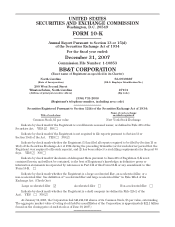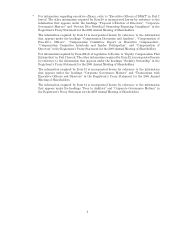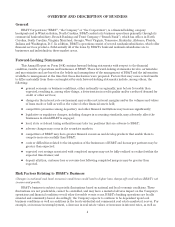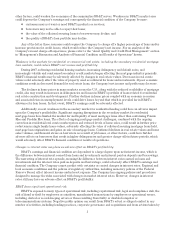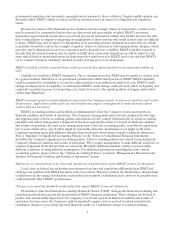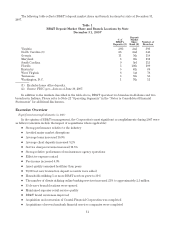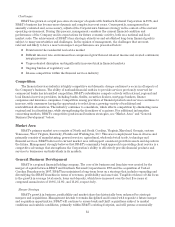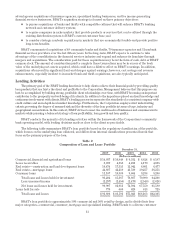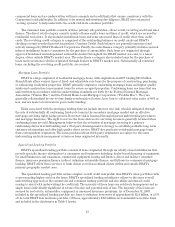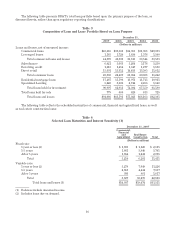BB&T 2007 Annual Report Download - page 7
Download and view the complete annual report
Please find page 7 of the 2007 BB&T annual report below. You can navigate through the pages in the report by either clicking on the pages listed below, or by using the keyword search tool below to find specific information within the annual report.BB&T may not be able to successfully integrate bank or nonbank mergers and acquisitions.
Difficulties may arise in the integration of the business and operations of bank holding companies, banks and
other nonbank entities the Company acquires and, as a result, the Company may not be able to achieve the cost
savings and synergies that it expects will result from such transactions. Achieving cost savings is dependent on
consolidating certain operational and functional areas, eliminating duplicative positions and terminating certain
agreements for outside services. Additional operational savings are dependent upon the integration of the
acquired or merged entity’s businesses with BB&T or one of BB&T’s subsidiaries, the conversion of core
operating systems, data systems and products and the standardization of business practices. Complications or
difficulties in the conversion of the core operating systems, data systems and products may result in the loss of
customers, damage to BB&T’s reputation within the financial services industry, operational problems, one-time
costs currently not anticipated or reduced cost savings resulting from such mergers or acquisitions. Annual cost
savings in each such transaction may be materially less than anticipated if the holding company, bank merger or
nonbank merger or acquisition is delayed unexpectedly, the integration of operations is delayed beyond what is
anticipated or the conversion to a single data system is not accomplished on a timely basis.
Difficulty in integrating an acquired company may cause the Company not to realize expected revenue
increases, cost savings, increases in geographic or product presence and/or other projected benefits from the
acquisition. The integration could result in higher than expected deposit attrition, loss of key employees,
disruption of BB&T’s businesses or the businesses of the acquired company, or otherwise adversely affect the
Company’s ability to maintain relationships with customers and employees or achieve the anticipated benefits of
the acquisition. Also, the negative effect of any divestitures required by regulatory authorities in acquisitions or
business combinations may be greater than expected.
BB&T may not receive the regulatory approvals required to complete a bank merger.
BB&T must generally receive federal regulatory approval before it can acquire a bank or bank holding
company. In determining whether to approve a proposed bank acquisition, federal bank regulators will consider,
among other factors, the effect of the acquisition on competition, financial condition and future prospects
including current and projected capital ratios and levels, the competence, experience and integrity of
management and record of compliance with laws and regulations, the convenience and needs of the communities
to be served, including the acquiring institution’s record of compliance under the Community Reinvestment Act
and the effectiveness of the acquiring institution in combating money laundering activities. In addition, BB&T
cannot be certain when or if, or on what terms and conditions, any required regulatory approvals will be granted.
In specific cases the Company may be required to sell banks or branches, or take other actions as a condition to
receiving regulatory approval.
BB&T may experience significant competition in its market area, which may reduce the Company’s customer
base.
There is intense competition among commercial banks in BB&T’s market area. In addition, BB&T competes with
other providers of financial services, such as savings and loan associations, credit unions, consumer finance companies,
securities firms, insurance companies, commercial finance and leasing companies, the mutual funds industry, full-
service brokerage firms and discount brokerage firms, some of which are subject to less extensive regulations than
BB&T is with respect to the products and services they provide. Some of BB&T’s larger competitors, including certain
national banks that have a significant presence in the Company’s market area, have greater resources than BB&T,
may have higher lending limits and may offer products and services not offered by BB&T.
BB&T also experiences competition from a variety of institutions outside of the Company’s market area.
Some of these institutions conduct business primarily over the Internet and may thus be able to realize certain
cost savings and offer products and services at more favorable rates and with greater convenience to the
customer.
Changes in banking laws could have a material adverse effect on BB&T.
BB&T is extensively regulated under federal and state banking laws and regulations that are intended
primarily for the protection of depositors, federal deposit insurance funds and the banking system as a whole. In
addition, the Company is subject to changes in federal and state laws as well as changes in banking and credit
7

